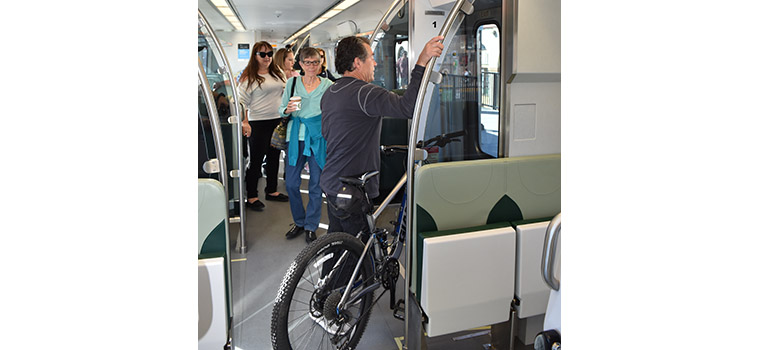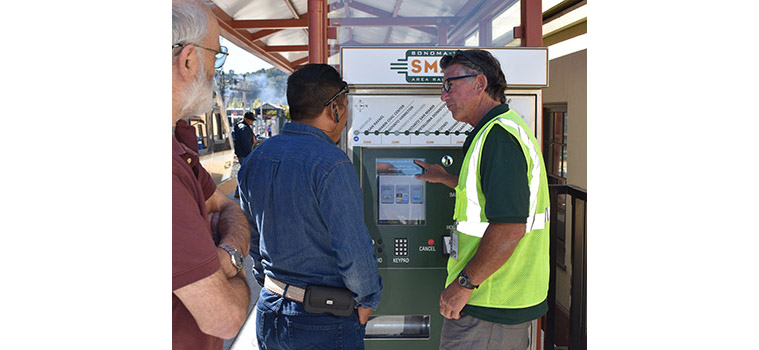Sonoma-Marin Area Rail Transit (SMART) is the Bay Area's newest passenger rail service, providing a new option to avoid the weekday highway 101 gridlock from highway 37 to Santa Rosa.

The number of people bringing bicycles on the train has been higher than expected, forcing SMART officials to look into ways to accommodate the large demand. Photo by Joel Williams
BC STAFF REPORT
Published: November, 2017
Sonoma-Marin Area Rail Transit (SMART) is the Bay Area’s newest passenger rail service, providing a new option to avoid the weekday highway 101 gridlock from highway 37 to Santa Rosa. The initial 43-mile system, which began service in late August, includes stations in the Sonoma County Airport area, Santa Rosa, Rohnert Park, Cotati, Petaluma, Novato and San Rafael.
SMART fares are based on the distance traveled, with 50 percent discounts available for seniors, youth and for passengers with disabilities. Substantial commuter discounts are also available through SMART’s annual Eco-Pass or through SMART’s 31-Day Pass program.
SMART uses the Clipper Card system for a smooth and seamless connection to other Bay Area public transit services. In connection with SMART’s start of service, several public transit agencies have developed new routes or adjusted existing ones to coordinate with the train’s schedule.
SMART passengers also receive transfer credits to make their connections with a $1.50 discount ($0.75 for youth, seniors and passengers with disabilities) when transferring to Golden Gate Transit, Marin Transit, Petaluma Transit, Santa Rosa CityBus or Sonoma County Transit — all of which also accept Clipper as fare payment. The same discount applies when you transfer from one of these public transit providers to SMART and pay with cash value.
An extension expected to be completed in early 2019 will take the line to the ferry terminal at Larkspur for an easy ride across the Bay to San Francisco. This $36.3 million project includes construction of the 2.2-mile extension, the center platform station and two new bridges as well as reconstruction of a trestle and improvements to the Bettini Transit Center in downtown San Rafael.
“This is an important milestone for us,” said SMART Board Chairwoman Debora Fudge. “This extension provides a link to the Larkspur Ferry and will connect SMART passengers with employment centers, entertainment, recreation and all of the benefits San Francisco has to offer. It will also connect visitors and others coming from San Francisco with the North Bay, showcasing our local shops, employers, wineries, restaurants and more.”
While work on the Larkspur extension is underway, SMART and Golden Gate Transit have partnered to offer SMART passengers free bus service from its San Rafael station to the Larkspur Ferry terminal. Future extensions are planned further north to Windsor, Healdsburg and Cloverdale, with the completed line planned to run 70 miles.
SMART General Manager Farhad Mansourian, who received a standing ovation at the grand opening for his role in overseeing the project over the last six years, provided a capsule history of the project at that event. He noted that as early as the 1980s, a group of Marin and Sonoma County residents had the vision to save the Northwestern Pacific right-of-way, which was being abandoned.
“They had the idea of preserving this right of way for future passenger rail service,” he said. Then came legislation that provided seed funding to purchase the right of way. “That was the beginning of our journey,” he said.
Another breakthrough came in 2008 when Marin and Sonoma counties passed Measure Q with 70 percent of the vote, establishing a quarter-cent sales tax to finance the system. The global financial meltdown put a crimp in the project’s coffers, but Mansourian said the planners overcame that hurdle by creatively phasing the construction.
The initial SMART system cost, including the seven inaugural two-car train sets, came in at roughly $500 million. Ultimately, it took a combination of federal, state, regional and local funds to buy the right of way, lay the rails, engineer and install a state-of-the-art control system, and build the rail cars. SMART’s initial passenger train service includes 34 trips each weekday, and limited weekend service, with the weekend runs designed to connect with the Larkspur Ferry.
Rider Comfort
SMART trains feature large, comfortable seats with tray tables and ample overhead storage. Each two-car train has space for 24 bicycles and includes a service area where passengers can purchase food and beverages. SMART trains are equipped with restrooms and free wi-fi. The trains also have large windows so that riders can sit back, relax and enjoy the scenic North Bay views.
Green Technology
SMART trains are equipped with the latest clean diesel engines, with SMART being the first rail service in North America to use Environmental Protection Agency Tier 4 engines. SMART’s fuel-efficient engines feature catalytic reduction technology that reduces particulates.
Early Growing Pains
Initial ridership numbers for the service have far exceeded expectations, with almost 53,000 passengers in the first three weeks of operation—well over the 46,800 passengers projected. Although each train can accommodate 300 passengers, a full train will find about half of them standing during morning and evening commutes.
The number of people showing up with bicycles has also been far more than expected, causing cars during high commute hours to quickly become filled to capacity. Nearly 3,800 bicycles boarded the trains during the first weeks of operation, with some days seeing up to 800 bicycles total. SMART officials said that they are looking into ways to accommodate the large demand for passengers with bicycles.
Another frequent passenger com-plaint concerns the schedule. On week-day evenings, there is a 90-minute gap between the 5:29 p.m. train departure from San Rafael and the next train at 6:59 p.m. Many passengers feel this causes an undue inconvenience for those that miss or are left behind by the 5:29.
For more information on fares and schedules, visit www.sonomamarintrain.org.

SMART uses the Clipper Card payment system, which provides for a smooth and seamless connection to other Bay Area public transit services. Photo by Joel Williams

An added perk for SMART passengers is a snack bar with food and beverages, including beer and wine, to enjoy on the ride home. Photo by Joel Williams

